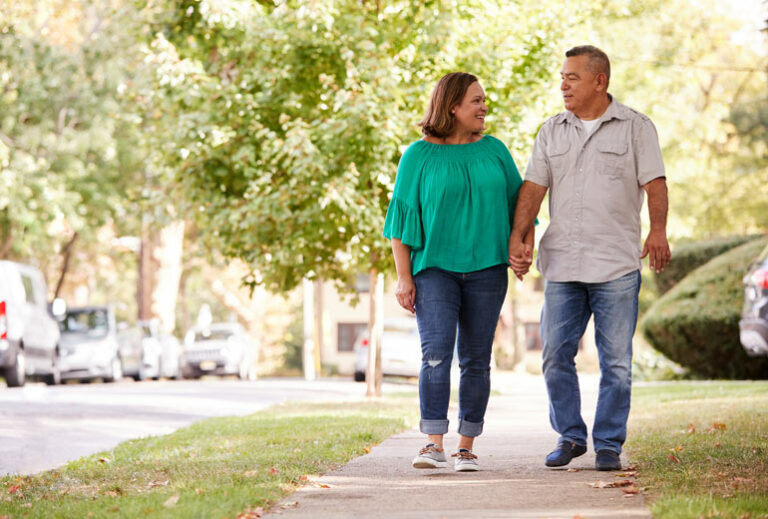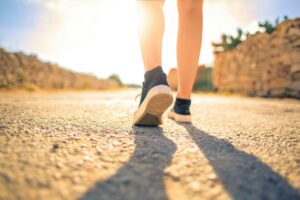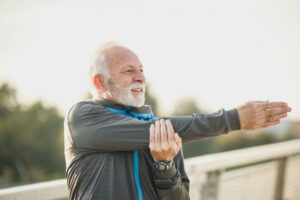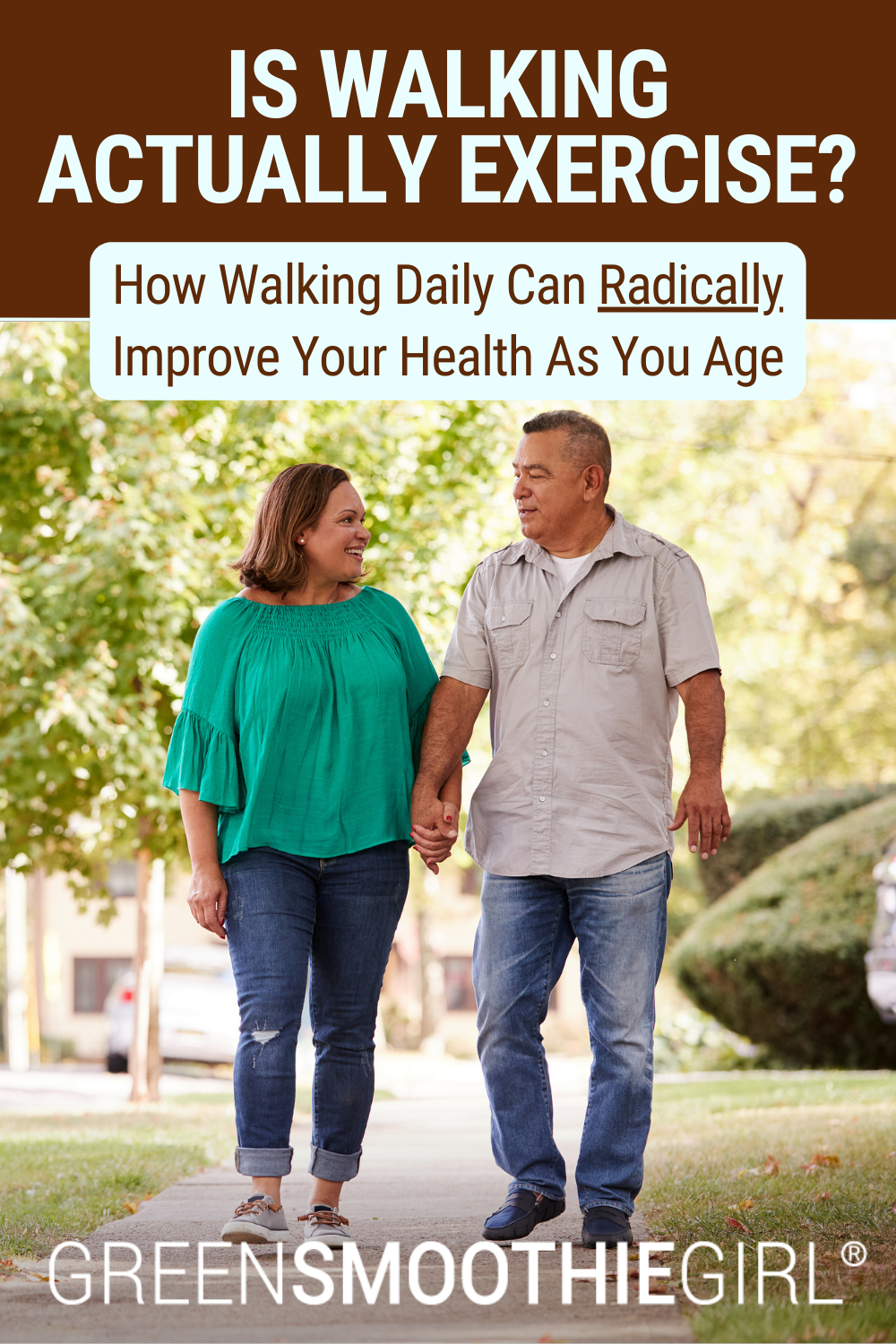Is Walking Actually Exercise? How Walking Daily Can Radically Improve Your Health As You Age

What if a simple activity – walking – holds the key to combating chronic disease, reducing medical costs, and alleviating stress?
During my time in Utah, I loved hiking. And now, in Florida, I enjoy walking on the beach.
Wherever you live, you can likely find a place to walk nearby, whether it's a walk in your neighborhood or on a trail.
Walking is easy and enjoyable. Just lace up your shoes and start. Yet, its benefits are more profound than you may realize.
I examined the numerous reasons why regular walking – ideally daily, or at least regularly – is a fantastic choice for achieving and maintaining optimal health.
And also, the specific type of walking that research indicates can yield meaningful benefits.
After reading this, I bet you’ll want to walk more often.
Here’s what you’ll explore in this article:
- The healthiest populations in the world walk daily
- 12 benefits of walking for your health
- How often should you walk? And what type of walking is best?
- Tips to help you walk more and gain the most benefits
Rethinking Walking
The primary preventable causes of chronic disease and premature death are unhealthy behaviors. Research suggests that the top four unhealthy behaviors are:
- Tobacco use,
- Alcohol use,
- Diet, and
- Physical inactivity
Surprisingly, only 3% of American adults had all four indicators of a healthy lifestyle, according to 2000 national survey data. Additionally, 5.3 million people are reported to die prematurely each year due to physical inactivity.1
Maybe you eat mostly healthy and you limit or avoid alcohol and tobacco.
But, how often do you engage in physical activity? Do you view walking as a legitimate form of exercise?
Do you have the idea that if it’s not running, or CrossFit, or something very hard – it’s not valuable?
In research, participants often perceive walking as merely a means of transportation.
However, this simple activity – accessible to most – can profoundly impact your health, including mental health.
The World’s Healthiest Populations Walk Daily

People in the Blue Zones – the longest, healthiest populations – walk outside daily.
In the Blue Zones, regions of the world with the highest concentrations of people over 100, walking is an essential part of their daily lives, which contributes significantly to their longevity./2
In these areas, people also engage in other low-intensity physical activities, such as gardening and manual labor. Other factors contributing to their health include diet and social connectedness.
For example, in the Nicoya Peninsula of Costa Rica, where the terrain is hilly, residents walk long distances daily, to work or to visit friends and family.
They also eat plenty of whole grains, fruits, and vegetables. But, my research in the last year has caused me to believe that physical activity is the single most important factor in our health – ahead of nutrition, even!
11 Benefits of Walking for Your Health
Why walk more? The simple act of walking decreases the risk of cardiovascular disease, type 2 diabetes, cognitive impairment, and dementia, while also improving mental well-being, sleep, immunity, and longevity. Let’s review the research.
#1 — Walking Is Great for Your Heart
Walking, especially briskly, increases your heart rate, improving circulation and supporting heart function.
Regular walking has been shown to improve blood pressure3 and cholesterol4 – two well-known risk factors for heart disease.
Walking 30 minutes a day (at least five days a week) is associated with a 19% lower risk for coronary heart disease.5
Even better, walking is connected with a 43% lower stroke risk in women.6
#2 — Walk for Weight Loss
Do you think walking is less beneficial than other exercise for weight loss?
This isn’t necessarily true. Runners burned only 23 more calories per mile than walkers in one study.7
Walking for an hour a day was found to reduce the effects of obesity-promoting genes by half, compared to a sedentary lifestyle.8
Walking may even reduce your cravings for sugary snacks, which can help you stick to a healthier diet.9
[Related: How To Break Your Sugar Addiction in Only 4 Days]
Plus, walking is particularly beneficial for reducing belly fat.10
#3 — Walking Boosts Your Mood and Lessens Anxiety or Depression
When you walk, blood flow to the brain increases, and endorphins – feel-good hormones – are released, which reduces feelings of stress.
Walking can improve your mood, and even reduce feelings of anxiety and depression, according to a 2006 study.11
The researchers recommend 30 minutes of moderate intensity, like brisk walking, for three days a week, which they say is sufficient for these health benefits.
#4 — Walking Helps Keep Your Brain Sharp
In addition to helping you feel better by increasing blood flow to the brain, walking can positively impact your cognitive function.
Walking regularly can lead to improved memory and cognitive function in older adults, according to a study conducted over 12 weeks.12
Walking more often is also linked with greater gray matter – a measure of brain health – and a reduced risk of cognitive impairment, in research conducted with participants in late adulthood.13
#5 — Walking Boosts Your Immunity

People who exercise, including walking, at least 20 minutes a day for at least five days a week had 43% fewer sick days than more inactive participants.
Walking supports healthy immunity by increasing blood flow, reducing inflammation, and strengthening antibodies, which protect you from foreign substances, like toxins and allergens.
A 30-minute walk increases immune cells, including natural killer cells.14
People who exercise, including walking, at least 20 minutes a day for at least five days a week had 43% fewer sick days than more inactive participants.15 When the regular exercisers got sick, their symptoms were milder and went away more quickly.
#6 — Walking Helps Improve Your Gut Health
Just 30 minutes of daily walking can enhance gut microbiome diversity by 15% in adults over 50, according to a study published in Gut Microbiomes.16
The researchers linked this increased diversity to improved digestion and reduced markers of inflammation.
Regular exercise fosters a diverse and balanced gut microbiome, vital in digestion, nutrient absorption, and immune function.
Moving is also a natural stress reliever, which can be key because chronic stress is a common contributor to gut problems.
#7 — Walking Helps You Avoid or Lessen Arthritis
Walking is a low-impact exercise, so it doesn’t put much stress on your joints. Plus, it can help protect your joints over time and ease pain.
Walking (and any exercise) cuts the risk of developing arthritis.17 Additionally, walking has been shown to reduce arthritis pain when done consistently.
#8 — Walking Lowers Blood Sugar and Diabetes Risk
Walking is recommended to help lower blood sugar and the risk of Type 2 diabetes.
#9 — Walking Improves Lung Function
Regular movement increases the strength of the muscles around your lungs.
Brisk walking improves lung function in older adults, aged 60 and above, according to 2022 research.18
#10 — Walking is Good for Your Bones
Bone strength starts declining every year after age 40.
Walking only a mile a day can improve whole-body bone density in women, and slows the rate of bone loss in the legs, according to an older study.19
Newer research from 2022 recommends 30 minutes of brisk walking three or more times a week to prevent bone loss.20
#11 — Walking Eases Joint Pain
Walking helps protect your joints by strengthening the surrounding muscles.
For example, when you walk, your hamstrings and quadriceps – two muscles around your knee – are strengthened, which can help reduce knee pain.
#12 — Walking May Help You Live Longer
With all these proven benefits of walking, it makes sense that walking can help you live longer.
Research on middle-aged adults found that walking only 7,000 steps a day was associated with a 50 to 70% reduction in mortality.21
How Often Should You Walk? And How Much?
You’ve probably heard the recommendation to walk 10,000 steps daily – something you can measure with a pedometer or other devices.
While that would be great for you, it may not be necessary.
Research suggests that walking just 30 minutes daily has benefits, which is about 3,000 steps, depending on your speed. You can also split up your time, but be sure you walk at least 10 minutes each time you walk.22
If you can’t walk daily, multiple hour-long walks per week could help you decrease your risk of chronic disease.
All steps count. But, some steps count more. Picking up your pace, or walking longer, could lead to even more benefits.
I cannot find any evidence that 10,000 steps is a magic number. What if your goal, if you’re more sedentary than you’d like to be, was just to increase your steps per day, to whatever works for you?
Twice a day is even better than once.
I have a neighbor who walks his dog, Bentley, for two hours, twice a day, on the beach. Bentley does not let Jeff have a walking shift off–ever!
I’d thought he was about 70, when I met him two years ago, and found out the other day that he’s actually 83!
Tips to Help You Walk More and Enjoy More Benefits

Be sure you stretch before and after walking to prevent injuries and feel your best!
- Don’t forget to stretch. Loosening your muscles before you start walking is important, especially as you age. Focus on the muscles you’ll use when you walk. And then, spend a few minutes stretching after you walk, too, to reduce strain on your muscles.
- Motivate with music. Motivational music improves your mood and makes exercise feel easier, according to research published in the European Journal of Sport Science.23 Plus, music with a faster temp may help you walk more quickly.
- Shake up your routine. If you walk outdoors, you can keep your brain engaged by taking a different path regularly. Even doing your normal walk backward could make your walk more exciting.
- Vary your speed. Walking at a faster pace is linked with more significant benefits. However, you don’t have to walk quickly the whole time. You can try interval walking and alternate walking at a normal pace with walking quickly for a set amount of time. Like two minutes of normal walking, followed by two minutes of fast walking.
- Set regular reminders. It’s best to take short breaks while you work to stay focused and retain information. So, why not go for a walk? Setting reminders on your phone or computer will help you remember to get your body moving while giving your mind a rest.
- Walk with a buddy. Walking with someone can make it more fun and keep you motivated and accountable to sticking to your goals. Try asking a friend or neighbor to join you for regular walks.
- Feeling stuck? Stressed? Walk outside. Walking outdoors significantly improved creative thinking and the generation of new ideas, according to a study published in the Journal of Experimental Psychology.24 Walking outdoors also led to more relaxed, meditative states in research published in the World Leisure Journal.25
- Other activities count. Parking farther away and taking the stairs count as walking, too. So, don’t forget to consider those as you think about how much you walk each week. Stairwalking may even be more energizing than caffeine, as shown in a 2017 study of sleep-deprived women.26
Walking Is Wonderful – Will You Walk More?
You walk every day, but why not put your legs to work for your health?
Walking daily, or as often as possible, at a brisk pace (i.e. quickly and energetically) may be best. But, those 10,000 steps you’ve likely heard about? You might not need that many to gain significant benefits.
Just 30 minutes of walking, which can be broken up into 10-minute segments, is good for many benefits, according to research. Though, of course, walking more can give you even more results for your health.
Thinking about all the benefits of walking – for improved mood, heart health, immunity, and so much more – I wish we could all go on a walk together, come walk on the beach with me!
Read Next: Try This Easy, 4-Minute Workout

Disclosure: This post may contain affiliate links that help support the GSG mission without costing you extra. I recommend only companies and products that I use myself.

References
- Lee, I. M., Shiroma, E. J., Lobelo, F., Puska, P., Blair, S. N., Katzmarzyk, P. T., & Lancet. Physical Activity Series Working Group (2012). Effect of physical inactivity on major non-communicable diseases worldwide: an analysis of burden of disease and life expectancy. Lancet
- Ungvari, Z., Fazekas-Pongor, V., Csiszar, A. et al. The multifaceted benefits of walking for healthy aging: from Blue Zones to molecular mechanisms.
- Murtagh, E. M., Murphy, M. H., & Boone-Heinonen, J. (2010). Walking: the first steps in cardiovascular disease prevention. Current opinion in cardiology. https://doi.org/10.1097/HCO.0b013e32833ce972
- Williams, P. T., & Thompson, P. D. (2013). Walking versus running for hypertension, cholesterol, and diabetes mellitus risk reduction. Arteriosclerosis, Thrombosis, and Vascular Biology. https://doi.org/10.1161/ATVBAHA.112.300878
- Zheng, H., Orsini, N., Amin, J., Wolk, A., Nguyen, V. T., & Ehrlich, F. (2009). Quantifying the dose-response of walking in reducing coronary heart disease risk: meta-analysis. European Journal of Epidemiology. https://doi.org/10.1007/s10654-009-9328-9
- Take a walk, reduce your risk of suffering a stroke. Harvard Health Publishing.
- Wilkin, L. D., Cheryl, A., & Haddock, B. L. (2012). Energy expenditure comparison between walking and running in average fitness individuals. Journal of Strength and Conditioning Research. https://doi.org/10.1519/JSC.0b013e31822e592c
- Walking may lessen the influence of genes on obesity by half. Science Daily.
- Ledochowski, L., Ruedl, G., Taylor, A. H., & Kopp, M. (2015). Acute effects of brisk walking on sugary snack cravings in overweight people, affect and responses to a manipulated stress situation and to a sugary snack cue: a crossover study. PloS One. https://doi.org/10.1371/journal.pone.0119278
- Hong, H. R., Jeong, J. O., Kong, J. Y., Lee, S. H., Yang, S. H., Ha, C. D., & Kang, H. S. (2014). Effect of walking exercise on abdominal fat, insulin resistance and serum cytokines in obese women. Journal of Exercise Nutrition & Biochemistry. https://doi.org/10.5717/jenb.2014.18.3.277
- Sharma, A., Madaan, V., & Petty, F. D. (2006). Exercise for mental health. Primary Care Companion to the Journal of Clinical Psychiatry. https://doi.org/10.4088/pcc.v08n0208a
- Nishiguchi, S., Yamada, M., Tanigawa, T., Sekiyama, K., Kawagoe, T., Suzuki, M., Yoshikawa, S., Abe, N., Otsuka, Y., Nakai, R., Aoyama, T., & Tsuboyama, T. (2015). A 12-Week Physical and Cognitive Exercise Program Can Improve Cognitive Function and Neural Efficiency in Community-Dwelling Older Adults: A Randomized Controlled Trial. Journal of the American Geriatrics Society. https://doi.org/10.1111/jgs.13481
- Erickson, K. I., Raji, C. A., Lopez, O. L., Becker, J. T., Rosano, C., Newman, A. B., Gach, H. M., Thompson, P. M., Ho, A. J., & Kuller, L. H. (2010). Physical activity predicts gray matter volume in late adulthood: the Cardiovascular Health Study. Neurology. https://doi.org/10.1212/WNL.0b013e3181f88359
- Nieman, D. C., Henson, D. A., Austin, M. D., & Brown, V. A. (2005). Immune response to a 30-minute walk. Medicine and Science in Sports and Exercise. https://doi.org/10.1249/01.mss.0000149808.38194.21
- Nieman DC, Henson DA, Austin MD, et al. Upper respiratory tract infection is reduced in physically fit and active adults. British Journal of Sports Medicine.
National statistics. Center for Disease Control and Prevention. - Cataldi, S., Poli, L., Şahin, F. N., et al. (2022). The Effects of Physical Activity on the Gut Microbiota and the Gut-Brain Axis in Preclinical and Human Models: A Narrative Review. Nutrients. https://doi.org/10.3390/nu14163293
- National statistics. Center for Disease Control and Prevention.
- Novotová, K., Pavlů, D., Dvořáčková, D., Arnal-Gómez, A., & Espí-López, G. V. (2022). Influence of Walking as Physiological Training to Improve Respiratory Parameters in the Elderly Population. International Journal of Environmental Research and Public Health. https://doi.org/10.3390/ijerph19137995
- Krall, E. A., & Dawson-Hughes, B. (1994). Walking is related to bone density and rates of bone loss. The American Journal of Medicine. https://doi.org/10.1016/0002-9343(94)90111-2
- Lan, Y. S., & Feng, Y. J. (2022). The volume of brisk walking is the key determinant of BMD improvement in premenopausal women. PloS One. https://doi.org/10.1371/journal.pone.0265250
- Paluch AE, Gabriel KP, Fulton JE, et al. Steps per Day and All-Cause Mortality in Middle-aged Adults in the Coronary Artery Risk Development in Young Adults Study. JAMA Netw Open. doi:10.1001/jamanetworkopen.2021.24516
- Lee, I. M., & Buchner, D. M. (2008). The importance of walking to public health. Medicine and Science in Sports and Exercise.
- Elliot, D., Carr, S., & Orme, D. (2005). The effect of motivational music on sub-maximal exercise. European Journal of Sport Science. https://doi.org/10.1080/17461390500171310
- Oppezzo, M., & Schwartz, D. L. (2014). Give your ideas some legs: The positive effect of walking on creative thinking. Journal of Experimental Psychology: Learning, Memory, and Cognition. https://doi.org/10.1037/a0036577
- Bailey, A. W., Allen, G., Herndon, J., & Demastus, C. (2018). Cognitive benefits of walking in natural versus built environments. World Leisure Journal. https://doi.org/10.1080/16078055.2018.1445025
- Randolph, D. D., & O'Connor, P. J. (2017). Stair walking is more energizing than low dose caffeine in sleep deprived young women. Physiology & Behavior. https://doi.org/10.1016/j.physbeh.2017.03.013
Images
- Walking in Costa Rica image used under a Creative Commons license from Pexels
- Walking feet image used under a Creative Commons license from Pexels
- Image of man stretching from Free Range Stock
Posted in: Exercise, Health Concerns, Healthy Weight, Immunity, Lifestyle, Preventive Care, Stress Management














